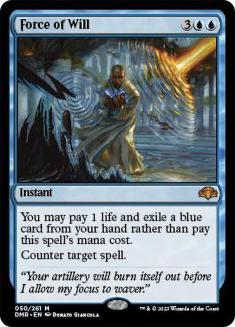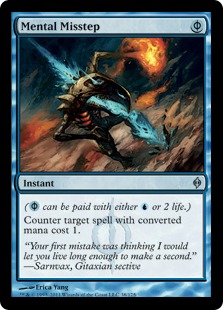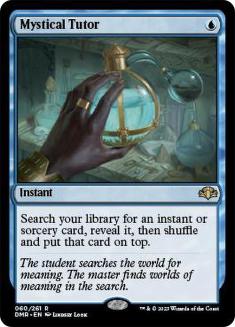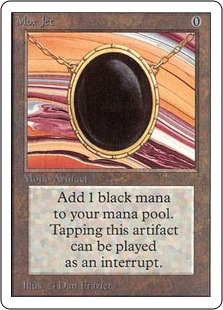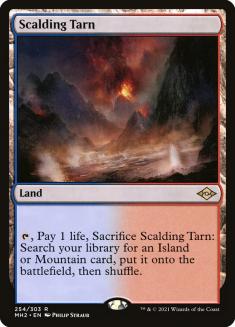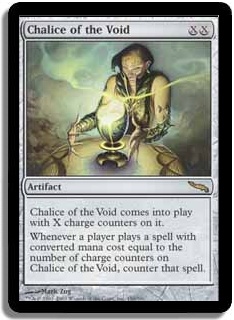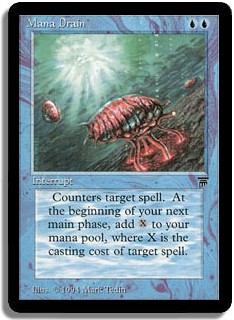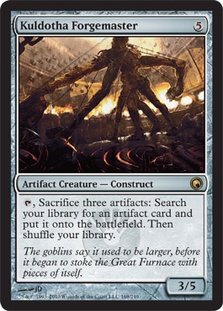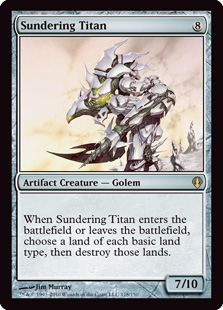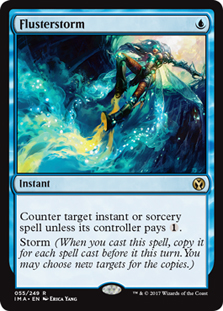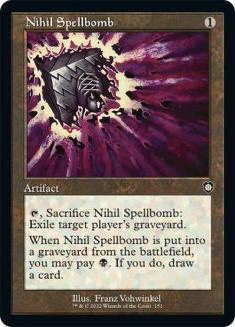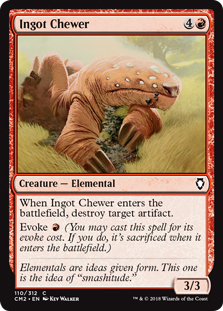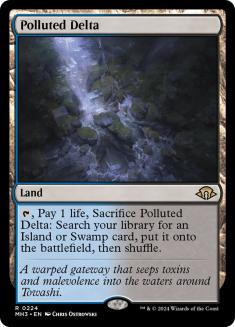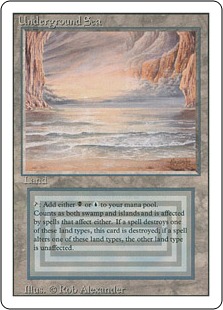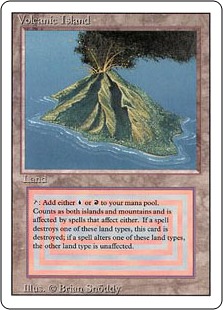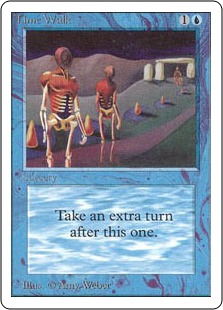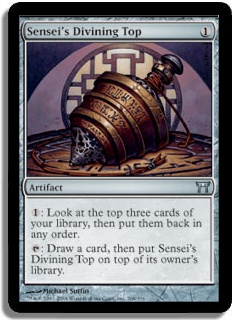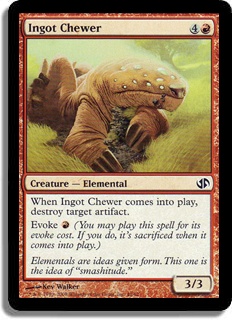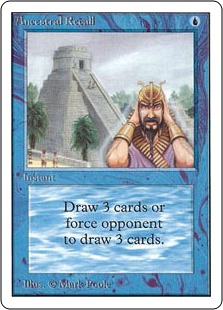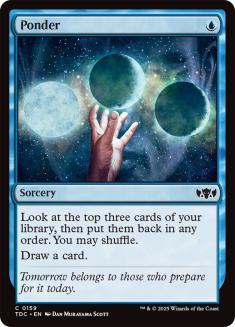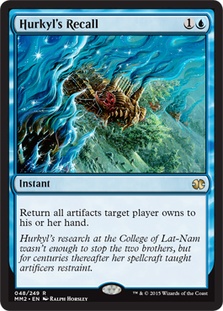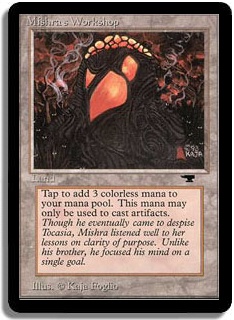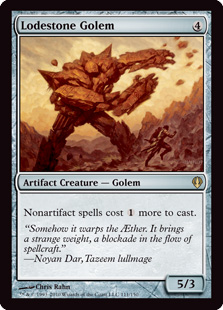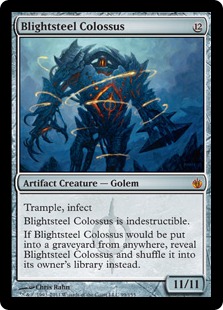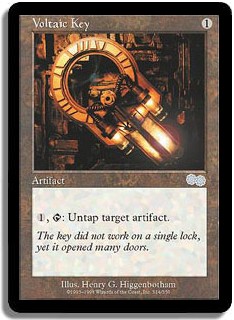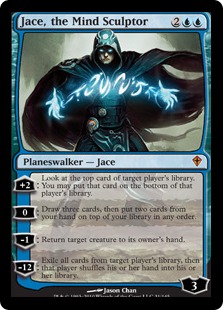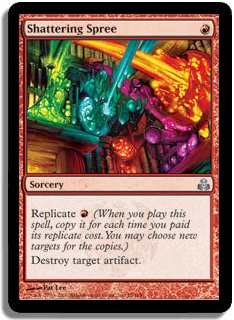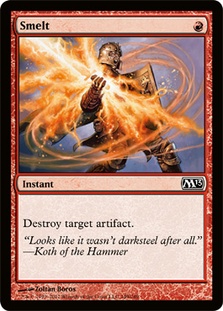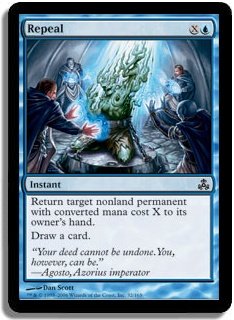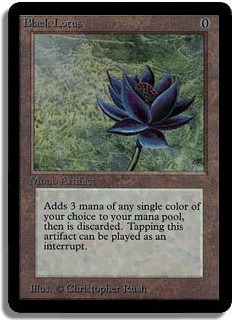Greetings Vintage fans! It’s been a couple of weeks since I last wrote about Vintage, but lo-and-behold, Vintage content is back in Avant-Garde country. My matchup analysis for the RUG Delver versus MUD matchup seems to have been popular with readers, so I thought pitting two more decks against each other in a fight to the death would be a good topic for today’s article.
Introducing the defending champion:
Creatures (8)
Planeswalkers (2)
Lands (15)
Spells (35)
- 1 Sensei's Divining Top
- 1 Brainstorm
- 2 Mana Drain
- 2 Lightning Bolt
- 1 Vampiric Tutor
- 1 Mystical Tutor
- 1 Yawgmoth's Will
- 4 Force of Will
- 1 Sol Ring
- 1 Demonic Tutor
- 1 Hurkyl's Recall
- 1 Time Walk
- 1 Ancestral Recall
- 1 Mana Crypt
- 1 Time Vault
- 1 Merchant Scroll
- 1 Tinker
- 1 Voltaic Key
- 1 Black Lotus
- 1 Mox Emerald
- 1 Mox Jet
- 1 Mox Pearl
- 1 Mox Ruby
- 1 Mox Sapphire
- 1 Nihil Spellbomb
- 3 Mental Misstep
- 2 Flusterstorm

And the challenger:
Creatures (17)
- 1 Sundering Titan
- 4 Lodestone Golem
- 1 Wurmcoil Engine
- 4 Kuldotha Forgemaster
- 1 Myr Battlesphere
- 3 Phyrexian Revoker
- 3 Phyrexian Metamorph
Lands (19)
Spells (24)

The first list I selected was Marc Lanigra’s Grixis deck from the Vintage Champs this summer. In case you don’t follow Vintage, Marc’s deck is the one that bested the field and took first place. The deck looked pretty sweet to me, and since I hadn’t actually gotten a chance to play with it and have wanted to get some games in, I figured it was a good place to start.
The challenger was my friend Jon Johnson’s MUD list, which seems to be a pretty standard Workshop deck.
Game I
The match started off poorly for me, and by poorly I mean that I didn’t win the die roll to go first, which is pretty important in any matchup that involves the card Mishra’s Workshop.
I fanned out my opening hand knowing that I would be on the draw…
Against Workshops and especially on the draw, this is pretty much a snap keep. Force of Will is the card that I most want to have in my opening hand against MUD on the draw, and by virtue of having it my chances of winning the game improve drastically. Also, I would add that in general against any unknown deck in a game 1 on the draw situation I would keep this hand.
Jon mulliganed his initial seven card hand but decided to keep his next hand of six.
Turn I
John led off with a Chalice of the Void for zero. It was a tough call; I did have a Mox Jet in my hand, but I opted to let it resolve. I really didn’t like Chalice in play, but here is the reason why I didn’t Force it: I was worried that he had a second Chalice of the Void that he could play out, which would basically negate my Force of Will + blue card + one life. I was also worried that he could have Workshop, Sol Ring, or Mana Crypt into a Lodestone Golem or Trinisphere.
“To Force of Will or not to Force of Will, that is the question…”
In addition to this thought process, because he had mulliganed there was a chance that he had a threat light hand, in which case two Force of Wills coupled with my ability to play a few lands might be good enough to pull ahead. Forcing the Chalice and then having him play a second Chalice would be a really good way for me to sacrifice my only way of gaining a significant advantage.
It is worth noting that had I started with two Moxes in my opening hand, the decision would easily have been to Force of Will the Chalice since one of his cards would be negating two of my cards. Trading one for one his Chalice against my Mox, especially with him on the play and having mulliganed, seemed fine. Forcing and then having him play a second would let him trade a two for three and could potentially bury me on the first turn.
Plus, countering the one he had to pay mana for would net me more advantage from my Force, which is what happened anyway.
He then played a Mishra’s Workshop and used it to cast a Thorn of Amethyst. I usually don’t like to counter Thorns—especially in a deck with seven two-drop creatures—but it was important for me not to fall too far behind here. I was basically locked into only being able to go +1 mana each turn (and only if I played a land), and if he had another Sphere effect I would almost certainly have to counter it anyway. So he baited out my Force and passed the turn.
M: 19
J: 20
On my turn I drew:
“Any blue card will do…”
Drain was a pretty good draw here because I wanted to use my mana to cast Mystical Tutor for Ancestral Recall and still have the ability to cast my other Force of Will this turn.
I played my Scalding Tarn and pass the turn.
Turn II
John drew and then played a second Mishra’s Workshop and cast Kuldotha Forgemaster. I countered the Forgemaster with Force of Will (18) pitching Mana Drain, and then on his end step I cracked my Tarn (17) for a basic Island and cast Mystical Tutor, which put Ancestral Recall on top of my deck.
M: 17
J: 20
On my turn I drew Ancestral Recall, and since it was the only spell in my hand I could cast (a Mox Jet that was blocked by Chalice of the Void being the other) I decided it prudent to fire it off to look for options.
But no lands came…
My Ancestral Recall yielded Nihil Spellbomb, Flusterstorm, and Mana Drain. So I played and cracked my Tarn (16) for an Underground Sea to put Nihil Spellbomb into play, hoping to cycle it next turn in search of a third land.
Turn III
John played Ancient Tomb and tapped it (18) along with his Workshops to add Kuldotha Forgemaster and Sphere of Resistance to the mix. The Forgemaster was almost certainly going to seal my fate because I assumed it would get a Sundering Titan to decimate my meager pile of lands, leaving me unable to cast any more spells.
“The clock is ticking…”
I was in pretty big trouble here…
I drew a Dark Confidant that I could not play because of the Sphere and decided to cycle my Spellbomb up front looking for a land drop. The best card I could draw here was a fetchland, which wouldn’t die to a potential Titan. I was rewarded with a Hurkyl’s Recall that I would never be able to cast.
Turn IV
On Jon’s turn he sacrificed the Forgemaster to Tutor up Sundering Titan, which annihilated my Island.
I drew Blightsteel Colossus and was content to give up on this game.
MUD: 1
Grixis: 0
Sideboarding
The good news was that I got to be on the play and that I got to board out all of my bricks like Mental Misstep and Flusterstorm for cards that could actually deal with Jon’s artifacts.
OUT:
IN:
Game II
I took the play and surveyed a pretty good opening hand:
“Force of Will on the play against MUD is a pretty big game.”
Jon also kept his hand of seven cards.
Turn I
I led off with Mox Jet, Volcanic Island, and Time Walk.
Turn I.5
I drew Jace, the Mind Sculptor, which I could not play yet. So I made the only play that I had, which was to put Polluted Delta onto the battlefield.
On Jon’s turn he was pretty productive. He started off by playing Mox Jet, Mox Pearl, and then casting Thorn of Amethyst. I decided not to counter it even though if he had nothing else I would be able to play my Jace and by not countering it I would probably not be able to cast Jace next turn. The reason was that I wanted to save my Force of Will for a card that was going to actually cause me trouble, a Lodestone Golem, Forgemaster, etc. Also, I knew that he could have a Workshop into something spicy. For instance, if he played a second Thorn I would have basically wasted my Force of Will!
It was relevant that he had already used three cards from his hand and a land would make four, so it was very possible that he would only have one or two threats I would need to deal with in the next two to three turns.
Even more significant, I was already pretty far ahead on the board with three mana in play and a forth in my hand to play. The Thorn wasn’t really going to mash me up very much at this juncture in the game, and I was more concerned with actually dealing with his threats (in particular, Lodestone Golem and Kuldotha Forgemaster).
It is really important when playing against Mishra’s Workshop with a blue deck to understand how much pressure you are under and to use your resources accordingly to deflect and manage this pressure. I see a lot of players make plays that end up biting them in the butt. For instance, if you Force of Will the Thorn of Amethyst and they just play a Sphere of Resistance. You still cannot play the Jace, but now you don’t have any defense against the Kuldotha Forgemaster that may very well be joining the party next turn.
Another thing to consider is that I didn’t need to play the Jace, the Mind Sculptor. It could simply be pitched to a Force of Will, leaving me with the ability to draw another blue card to pitch to the other Force of Will. If I drew a Dark Confidant, maybe getting Jace into play would become less important than simply stopping his creatures from entering play while I draw a bunch of cards and hit him with Bob.
Since the Thorn was merely a little bit annoying and not really putting me under any real pressure to produce plays (I still felt ahead with a Thorn on the battlefield), I was happy to let it resolve in order to extract more value from my Force of Will later when it would likely make a bigger impact.
He followed up with a Workshop, Chalice on zero, and a Grafdigger’s Cage and then passed the turn.
Turn II
On my turn I drew Sensei’s Divining Top and cast it tapping Volcanic Island and Mox Jet, and then I played my Underground Sea. I did it this way so that I would have options with regard to my play.
On his turn, if he played a Phyrexian Revoker I would have to option to activate Top rearrange the top cards and flip the Top atop my deck, forcing him to make a decision about whether to Revoke the Top on top or the Mox Jet in play. I’d happily get my Mox Revoked so I could redraw the Sensei’s Top and recast it. If he still Revoked the Jet, I could simply shuffle it away. Also, I have the option if he doesn’t present me with a card worth Forcing to end of turn spin the Top and possibly shuffle the top three cards away if they are not what I want.
“Limitless lines of play.”
Turn III
No Revokers from Jon, but a big turn nonetheless. He played Mishra’s Factory and then cast Kuldotha Forgemaster (the reason we don’t arbitrarily Force a Thorns…), which got countered by my Force of Will pitching my other Force of Will.
I cracked my Polluted Delta and spun my Sensei’s Divining Top, which revealed three good ones: Lightning Bolt, Chewer, and Scalding Tarn. After thinking for a moment, I decided that what I really wanted was to get my Jace into play, so I left the Tarn on top knowing I would have to shuffle away two good cards. The reason was that if I drew the Bolt or the Chewer I would not get to develop my board on my turn, which is really important since getting to put two cards into play (one being Jace) is pretty good.
M: 18
J: 20
Turn IV
I drew the Scalding Tarn I left atop my deck, cracked it for another Volcanic Island, and used it to slam down Jace on my side of the board. He had a Mishra’s Factory in play to attack Jace, but he was low on cards in hand. The only play he could make that could punish me for Brainstorming would be to play a second Factory and attack and pump. But even if this was the play I still had other gas available to me in the form of my Top. So I decide to put the pressure on him to have his card. Besides, with all of the mana I had on the board I really just needed to continue gassing up in order to beat back his pretty mediocre pressure.
I used Jace’s +0 ability and saw Dark Confidant, Ingot Chewer, and a fetchland. I drew the Chewer and put the Bob and fetch back on top.
On Jon’s turn he used the rest of his resources to attack my Jace, the Mind Sculptor with his Factory down to one loyalty and then cast Chalice of the Void set to two. He then added another Mishra’s Workshop to his side of the board and passed the turn.
Turn V
(I had a big turn here.)
I drew the Chewer and CAST IT, destroying his Chalice of the Void for two. I now had a 3/3 in play to protect my Jace by blocking down his Mishra’s Factory. I then Brainstormed, seeing two Dark Confidants and a fetchland. I kept the fetch, played it, and passed the turn.
“Just chillin’ making sure you can’t attack my Jace”
Back to Jon’s turn, he drew and played another Mishra’s Factory but decided not to trade his Factory for my Ingot Chewer. He was basically in a pretty bad spot here.
Turn VI
I drew for my turn, +0’d my Jace, and added two Dark Confidants to my side of the board.
On his turn he didn’t draw anything good, only a Wasteland which he used to kill an irrelevant land on my side before passing the turn.
Turn VII
I flipped over a land and a Hurkyl’s Recall, drew Yawgmoth’s Will, and then +0’d my Jace into Tinker for Black Lotus (and Yawgmoth’s Will back for Time Vault) and the Voltaic Key to go infinite.
I was a few mana short of executing the combo, so I had to pass the turn and end of Turn Hurkyl’s away his Thorn.
On Jon’s turn he could only add a Tangle Wire to the battlefield, which wasn’t nearly good enough. I Hurkyl’s Recalled him on his end step, forcing him to pick up his board.
Here is how we do.
EOT: Hurkyl’s Recall
My Turn: Tinker sacrificing Mox Jet for Black Lotus. Crack Lotus for black and cast Yawgmoth’s Will. Replay Mox Jet and Black Lotus. Sacrifice Black Lotus for blue and Mox Jet to cast Tinker from my graveyard fetching Time Vault. Play Voltaic Key from my hand and tap Voltaic Key to untap Time Vault. Then tap Time Vault to take the next turn, the next turn, the turn after that, and then some more turns.
And we are all tied up at one…
MUD: 1
Grixis: 1
Game III
I was back on the draw and was forced to mulligan to six, but a ‘good six.’
Turn I
I had fortunately drawn another hand with Force of Will in my opener. Unfortunately my opponent had also drawn another hand with Mishra’s Workshop in HIS opener! The battle was on!
“GAME ON!”
Jon came out of the box with Mox Ruby, Chalice of the Void for zero, Workshop, and Lodestone Golem. The Golem died to my Force of Will pitching Ponder (19).
M: 19
J: 20
On my turn I drew Mystical Tutor, played my Ancestral Recall targeting myself, and drew Dark Confidant, Jace, the Mind Sculptor, and Mountain.
Turn II
On Jon’s turn he didn’t have another land but followed up with another Lodestone Golem, which was met with a frown from this Grixian.
On my turn I drew Voltaic Key, played Mountain, and passed the turn.
Turn III
On Jon’s turn he attacked me with Lodestone Golem (14) and cast ANOTHER LODESTONE GOLEM. In response to the second Golem I tapped my Mountain and Underground Sea to cast Mystical Tutor to find a Lightning Bolt.
On my turn I played the Volcanic Island and Lightning Bolted one of his Lodestone Golems.
“Unfortunately for giant metal creatures, they attract bolts of lightning from the Grixis sky.”
Turn IV
On Jon’s next turn he played Ratchet Bomb and a Thorn of Amethyst and attacked me again (9).
On my turn I didn’t draw a fourth land so I simply cast my Dark Confidant and passed the turn. He charged his Ratchet Bomb on my end step to one counter.
Things were looking grim for our hero…
Turn V
Jon finally drew a second land, an Ancient Tomb, and used it (18) to add Wurmcoil Engine to his side. He then attacked with his Lodestone Golem, dropping my life total down to (4) before passing the turn back to me.
On my upkeep Dark Confidant revealed Scalding Tarn (whew!), and I drew Mana Drain for the turn.
I played the Tarn and cracked it (3) to play Time Walk. I had no attacks because he had the Wurmcoil Engine in play.
“It’s going to be one of those ‘Dark Confidant, Time Walk, I’m at 3, and need to flip lands’ kind of games.”
Turn V.5
Dark Confidant once again treated me well, revealing Mox Pearl. I then draw Island for my turn. I decided to main phase Hurkyl’s Recall and attack for two with Dark Confidant (16).
Main phase Hurkyl’s Recall was clearly the play here for a number of reasons. Firstly, if I waited until his turn he would be able to charge his Ratchet Bomb again and kill my Dark Confidant. Secondly, I wanted to be able to play out my Mox and cast my Voltaic Key while all of his Chalices and Spheres were up. There was no point in waiting because I would have to Hurkyl’s him during his attack step to not lose the game to his two attackers anyways.
So I cast Hurkyl’s Recall on him, and while his shields were down I produced a Mox and a Voltaic Key.
Turn VI
On Jon’s turn he played Mox Ruby, Mox Pearl, Mox Sapphire, Chalice of the Void for zero, Mishra’s Workshop, Thorn of Amethyst, and Lodestone Golem. Apparently he had drawn a couple of Moxes since laying his Chalice of the Void for zero.
Another big Dark Confidant flip was coming up…
At the beginning of my upkeep, Dark Confidant revealed…BLIGHTSTEEL COLOSSUS!!!
“Just kidding!”
That wouldn’t be a very good ending to our story now would it?
Luckily, Dark Confidant actually revealed a Snapcaster Mage, which dropped my life total to one, and then I drew Scalding Tarn for my draw step.
On my turn I was able to cast Jace, the Mind Sculptor and use the +0 ability to put the Tarn back on top of my library so I wouldn’t die from Dark Confidant.
On Jon’s turn he replayed the Wurmcoil Engine and Ratchet Bomb and then Strip Mined one of my lands. Since he knew I put the Tarn on top of my deck and having me see extra cards isn’t to his advantage, he attacked with Lodestone Golem and forced me to chump block with my Dark Confidant.
Turn VII
I drew the Scalding Tarn and +0’d my Jace, the Mind Sculptor into Time Vault, which I proceeded to cast.
“Is this good?”
With the Triforce clearly assembled, the game was over. Grixis defeated MUD by a score of 2-1 with a come from behind, on the draw, game 3 victory.
Final Thoughts on the Grixis vs. MUD Matchup
The third game was pretty epic, especially when one considers that the MUD deck was able to produce Lodestone Golems on turns 1, 2, and 3 on the play with a Chalice of the Void for zero! Also, the game was pretty notable in that the Dark Confidant flips for the Grixis side were very fortunate, as should be obvious due to the fact that Grixis’ Bobs flipped five times and only dealt three.
Jon and I played eight more pre-sideboard games after our match, alternating between the play and the draw. We split 4-4, with the player who took the play winning every single game.
Honestly, the matchup seems very close to me, and the determining factor appears to very significantly be whichever deck ends up getting the play has a very large advantage. In fact, the only game that we played where anybody was able break serve was the miraculous post-sideboard game 3 that we played. So my advice with regard to this matchup is to win the die roll and choose to be on the play.
I would speculate that although the matchup feels to be about 50-50 in the abstract, after the die roll is performed the player who steals the play is probably more realistically the 75-25 favorite to win.
Both decks are obviously very powerful, well built, and good at getting ahead and winning—hey, it’s Vintage, and that’s how things go.
Chalice of the Void is the key card at swinging the matchup so heavily to the person on the play’s favor since it essentially eliminates the blue deck’s Moxes if deployed on the play (which is a huge advantage), while on the draw becomes a mid-game tactic for stopping 1 and 2CC spells.
I have a few thoughts about the Grixis deck that I played with that I’d also like to share.
The first is that I felt like the Grixis deck was really, really soft to Chalice of the Void set for two in game 1. I actually had no way to remove a Chalice for two, and it was very difficult to try to win through it. Basically, the only out to this combination of cards is Tinker for BSC, which kind of sucks against MUD’s Metamorphs, or to play Voltaic Key and Tinker for Time Vault. I would kind of like to play with a card in the maindeck that is capable of removing a Chalice on two.
I would suggest these as possible cards for consideration:
“Can kill a Chalice of the Void for two and play nice with Snapcaster Mage.”
Jon is a good player, and once he knew the contents of my deck Chalice of the Void for two became his best possible tactic against me in our pre-sideboard games. This is something that MUD players should take note of against Grixis.
Especially with Mystical Tutor and Vampiric Tutor in the deck, there were many times where I would have a Tutor in hand and simply have nothing good to get once the Chalice did hit the board, which is something to consider.
The other critique I have of the deck is that I really didn’t like Blightsteel Colossus. I hear he is pretty good in other matchups, but man this card is painful to draw or flip to Dark Confidant. I also don’t like the fact that putting him into play against Mishra’s Workshop is often a misplay because they can essentially negate him with a Metamorph at the cost of one of your Moxen.
I would suggest this as a possible card for consideration:
“More fair but less of a liability?”
I think that Wurmcoil, while objectively much less powerful because it can’t ‘one shot’ an opponent, is a card that I would rather play with in this deck. First of all, this card is very castable against MUD in the mid game. Second of all, he doesn’t snap kill you when you flip him to Bob. And lastly, he provides the ability to gain life, which is an effect that this deck doesn’t actually have but would probably like access to.
I played eleven games against MUD, and there wasn’t a single one where I put or wanted to put BSC into play. There were two games where I had BSC in hand and could have cast a Wurmcoil. I am not really a fan of BSC in general, so others might not share my thoughts on this subject. I would actually strongly consider sideboarding him out for Engineered Explosives, whereas if I had Wurmcoil I wouldn’t even consider siding that robot out. Food for thought…
The last thing is that I definitely want to find room for a third Jace, the Mind Sculpter. I was really impressed with how important that card was for actually winning the game against Workshop. Also, I was fairly unimpressed with Snapcaster Mage in this matchup. With that in mind, I would cut the third Snapcaster Mage for the third Jace, the Mind Sculptor.
Another snippet that I think is significant is that most of the pressure to make game-deciding decisions rests upon the blue mage in this matchup. For the most part, from the Workshop side the plays tend to be fairly intuitive once you understand what is going on. That isn’t to say that “any old play will do” or that the MUD player doesn’t have to make decisions, but rather that MUD’s decisions tend to be more straightforward with regard to technical play.
More to the point, if a Shop player merely operates under the assumption that they utilize their mana most efficiently and pays no attention to tactics they will operate with some degree of success, especially in games where they are on the play. Obviously, this won’t generate the best possible results, but my point is that if the blue mage operates under the same assumption they will lose most of their games.
With this observation in mind, while I believe it is in everybody’s best interest to play at the highest level they possibly can, the burden of good play in this matchup lies even more squarely on the shoulders of the blue mage to recognize pressure and make good plays against MUD. For instance, it is really important not to throw counters away on the cards that don’t need to be countered, etc.
I have been battling back Workshops for almost a decade now and have played the matchup thousands of times, which makes a lot of this stuff second nature to me. However, getting that experience is really the best way to approach fighting MUD with blue decks and vice-versa. The matchup is actually a really difficult one to play correctly, and playing well and making good decisions are really important in order to be successful.
I hope you enjoyed the read.
In summary, try to win the die roll! If you can’t, be prepared to win a bunch of Dark Confidant flips and come from behind. And if neither one of these things are your style, there is always the option to tighten up and make smart plays…
May of all your Dark Confidants flip:
As always, thank you for reading.
Cheers,
Brian DeMars

